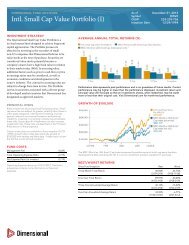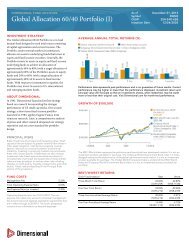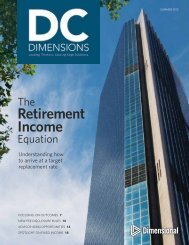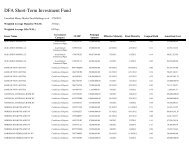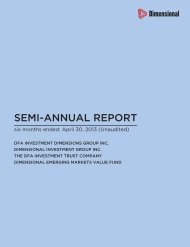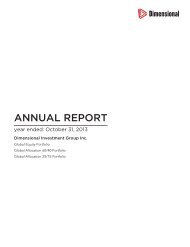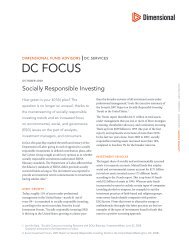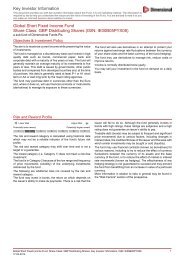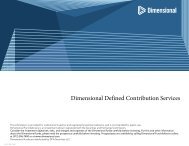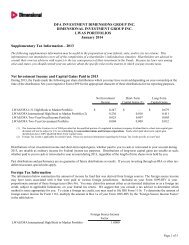Rebalancing and Returns.indd - Dimensional Fund Advisors
Rebalancing and Returns.indd - Dimensional Fund Advisors
Rebalancing and Returns.indd - Dimensional Fund Advisors
You also want an ePaper? Increase the reach of your titles
YUMPU automatically turns print PDFs into web optimized ePapers that Google loves.
<strong>Rebalancing</strong> <strong>and</strong> <strong>Returns</strong> 3<br />
In this paper, I attempt to document the relative importance of asset allocation, variance<br />
reduction, trading costs, <strong>and</strong> time-varying weights in the historical performance<br />
of several rebalancing strategies. The purpose is not to try to identify optimal rebalancing<br />
strategies that maximize portfolio returns, but to improve underst<strong>and</strong>ing about the<br />
benefits <strong>and</strong> limitations of rebalancing strategies reported in studies such as Daryanani<br />
(2008) <strong>and</strong> Plaxco <strong>and</strong> Arnott (2002).<br />
Replicating Daryanani’s Opportunistic <strong>Rebalancing</strong><br />
In this study, I reexamine the return benefit from Daryanani’s (2008) opportunistic<br />
rebalancing strategy. In his experiment, one portfolio was rebalanced, using a relatively<br />
large rebalancing tolerance (20% for each asset class). It was monitored daily to<br />
biweekly, <strong>and</strong> it had annual returns that were about 45-50 basis points higher on average<br />
than the non-rebalanced portfolio. Though this difference is small relative to the<br />
volatility of historical returns data, it is still unexpected given that a non-rebalanced<br />
portfolio will tend to have greater allocations in high-returning assets <strong>and</strong> would be expected<br />
to have higher returns over a sufficiently long sample. Daryanani’s conclusion<br />
that a rebalanced portfolio can do better than the non-rebalanced portfolio, even net of<br />
trading costs, is surprising <strong>and</strong> deserves closer inspection.<br />
I replicate his experiment, with some modifications due to data limitations. I consider<br />
a target portfolio with an initial investment of $1 million <strong>and</strong> with allocations of 25%<br />
in the S&P 500 Index, 20% in the Russell 2000 Index, 5% in the Dow Jones AIG Commodity<br />
Index, 10% in the Dow Jones Wilshire US REIT Total Return Index, <strong>and</strong> 40%<br />
in the Bloomberg US Government 7-10 Year Index. Daily data availability limits the<br />
sample to February 1996-June 2008. 2<br />
The opportunistic rebalancing strategy specifies both the timing <strong>and</strong> the tolerance b<strong>and</strong><br />
for rebalancing. Look intervals, which range from daily to annually, determine how frequently<br />
the portfolio is evaluated for rebalancing. The rebalance b<strong>and</strong>, which ranges<br />
from 0% to 25%, specifies how far each asset class is allowed to stray from the initial<br />
target allocation before rebalancing is required. The 0% rebalancing b<strong>and</strong> corresponds<br />
to calendar rebalancing where all classes are brought exactly to target at the end of each<br />
interval. The 100% rebalancing b<strong>and</strong> is the non-rebalanced case. 3 Asset classes that fall<br />
outside of the specified rebalance b<strong>and</strong> are rebalanced to within 50% of the rebalance<br />
b<strong>and</strong>. In this paper, I describe strategies using the notation (d, r%), where d is the look<br />
interval in business days <strong>and</strong> r% is the width of the rebalance b<strong>and</strong>.<br />
The rebalancing strategy is best demonstrated with an example. Consider the strategy<br />
(20, 10%), which dictates that the portfolio weights be checked every 20 business days<br />
2. There are two differences between my sample <strong>and</strong> that used by Daryanani. Daryanani uses the Dow<br />
Jones REIT Total Return index <strong>and</strong> his sample is from January 1992 to December 2004.<br />
3. In theory, rebalancing can still occur with the 100% b<strong>and</strong> (when an asset class swells to more than<br />
double its target weight), although that never occurs in the sample used in this paper.



